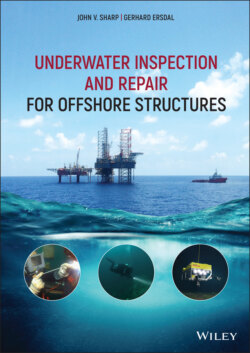Читать книгу Underwater Inspection and Repair for Offshore Structures - Gerhard Ersdal - Страница 27
2.2.3 Regulation in the UK Offshore Industry
ОглавлениеFrom 1974 until June 1998, the UK certification regime required the issue of a certificate of fitness every five years by legislation Sl 289, enacted in 1974 (Department of Energy 1974). This was the basis for the regulation of the safety of offshore structures in the UK sector of the North Sea. It was supported by published Guidance Notes, which included specific sections on design, construction, surveys and repairs (Department of Energy 1990). Most of the structures in the North Sea were designed, fabricated, installed and operated in this regime until 1996. The 4th edition of the Guidance Notes had extensive sections on both surveys and repairs. These are reviewed later in this book.
Following the Cullen report on the Piper Alpha disaster (Cullen 1990), a major change in the regulatory regime affecting structural integrity and safety issues for offshore installations was implemented in 1995 with the introduction of the Safety Case Regulations (HSE 2005) in 1995 and the Design and Construction Regulations (DCR) in 1996 (HSE 1996). As a result, all installations operating in the UK sector of the North Sea are now required to have an accepted safety case which needs to demonstrate that all hazards with the potential to cause a major accident have been identified, that the risk has been evaluated and that measures have been or will be taken to reduce the risk to a level that is as low as reasonably practicable (ALARP).
Hazards can arise for structures as a result of inadequate design, poor fabrication or potential failure of materials (e.g. brittle fracture and fatigue) and hence good design and fabrication, as well as effective materials selection, are part of the risk reduction process. ln addition, there is a requirement for the provision of a safety management system which demonstrates that the key factors for health and safety management—as identified in, for example, HSG65 (HSE 2013)—are in place.
The DCR introduced the concept of lifetime integrity. An important requirement is to ensure that as far as reasonably practicable, in the event of reasonably foreseeable damage, the installation will retain sufficient integrity to enable action to be taken to safeguard the health and safety of persons on or near it. The retention of residual integrity in the case of damage, such that evacuation can proceed as required, is an important aspect of this. Certain elements in the structure are safety critical and hence are deemed to be “safety critical elements” (SCEs) in the modified Safety Case Regulations HSE (2005).
For North Sea structures on the UK continental shelf (UKCS), preparation of an inspection plan is now a requirement of Regulation 8 of the DCR. This requires that the duty holder ensures that suitable arrangements are in place for maintaining the integrity of the installation, through periodic surveys and assessments and carrying out any remedial work in the event of damage or deterioration. Previously, the guidance (Department of Energy 1990) provided recommendations for the frequency of surveys during the five‐year period of the certificate of fitness, including its renewal, on the UKCS. This renewal period tended to determine the inspection schedule.
The Department of Energy Guidance (Department of Energy 1990) and also API RP‐2A (API 2014a) have been important sources of design information for a wide range of structural components. From 1998, however, the Department of Energy Guidance is no longer being maintained by HSE and an ISO standard for offshore structures, ISO 19902 (ISO 2007), is now the recognised standard for the UK. The ISO standard includes a substantial new section on structural integrity management and in‐service inspection which provides an international framework for this subject. The ISO procedure covers both in‐service inspection and structural integrity management, including collation of platform and inspection data and their evaluation to develop an inspection plan.
